The Boston Musical Instrument Company was an American manufacturer of brass band instruments in the late 19th and early 20th centuries located in Boston, Massachusetts.
The Boston Musical Instrument Company was an American manufacturer of brass band instruments in the late 19th and early 20th centuries located in Boston, Massachusetts.
Elbridge Wright was an apprentice to Samuel Graves at his original woodwind shop which had been founded in the 1820s in West Fairlee, Vermont and later headquartered in Winchester, New Hampshire. While in Winchester, James Keat, who had apprenticed to his father Samuel in England around the turn of the century, introduced the Graves firm to brasswind instrument manufacture. Wright learned from both Graves and Keat before setting out on his own. [1]
In 1869, the E.G. Wright Company of Boston, Massachusetts (established in 1841) and Graves & Co. of Winchester, New Hampshire combined to form the Boston Musical Instrument Manufactury located at 71 Sudbury Street, Boston. The partnership included Elbrdige G. (EG) Wright, Samuel, William and George Graves, and Wright’s "practical partners" Henry Esbach and Louis Hartman. [2] [3]
E.G. Wright left the company shortly thereafter to join the firm of Hall and Quinby (established by David Hall in 1862) which became The Hall Quinby Wright Company until Wright’s death in 1871. In the 1869 Catalogue announcing the formation of the Boston Musical Instrument Manufactury, an opening letter to customers cautions against any firms that might “advertise in the old name in order to enhance the value of inferior instruments”. The continued use of E.G. Wright & Co. tools, patterns and craftsman was assured in the same. [2] Hall and Quinby would be bought by Thomas and Odell in 1884 changing its name to the Standard Band Instrument company and then again in 1909 by the Vega Company. [4]
E.G. Wright and Company had been founded in 1841 and continued as the Boston Musical Instrument Manufactury uninterrupted at 71 Sudbury until 1902 when the name was changed to the Boston Musical Instrument Company. This change coincided with a relocation to 51 Chardon Street in Boston. Two years later the company was purchased by Cundy-Bettony which continued to build instruments in the Boston name until 1928. [5]

The Boston Musical Instrument Manufactury/Company was a producer of traditional instruments for brass band. The 1869 catalog shows a full line of such instruments including the traditional cornets in E-flat and B-flat, E-flat Alto horn and horn, B-flat tenor, B-flat baritone, B-flat valve trombone and slide trombone, and tubas in B-flat and E-flat. Slide cornet was another option. The company also offered the full range of instruments in upright bell and over the shoulder configurations. [2]

Initially, most valved instruments were offered in rotary valve configurations with piston valve cornet and alto horn being the only exceptions. The rotary valve is a string operated dual-bored axial valve actuated by a lever pressed with the fingers. A piston valve is directly actuated by downward finger pressure on the top of a dual-bored piston over a spring. Rotary valves were common in central Europe in the mid 19th century while piston valves were the preferred configuration in British brass bands. [2]
Among the American firms competing with Boston were the H.N. White Company, The Standard Band Instrument Company, C.G. Conn, Ltd., F.E. Olds, E.A. Couturier Co., Ltd., the Frank Holton Company and the J.W. York Company. All manufactured similar full lines for band.
Noted cornet virtuoso Herbert L. Clarke, author of many solos for cornet and successful touring soloist of the turn of the 20th century, purchased a Boston 3-star cornet for his first professional quality horn. [6] He purchased this horn after several months of saving following his graduation from high school and relocation to Indianapolis from Toronto in 1884. The Boston 3-star cornets were popular horns of the day and are still respected by collectors and antique cornet enthusiasts. These horns carried the inscription “Ne Plus Ultra” on the bell. Clarke had learned to play on his brother’s horn and then had played professionally for a time on a band provided Courtois. Clarke did not stay with the Boston for very long, changing horns and manufacturers many times in his career. [7]
The Boston Musical Instrument Manufactury/Company was a low volume producer by modern standards.
The company produced only 4000 to 4500 total instruments in each decade of the 1880s, 1890s, 1900s and 19-teens. Boston serial numbers do not appear on horns prior to 1880 and begin in the 6000s.
Around 1890 the serial numbers were in the 10,000 range, in 1900 the 15,000 range, in 1910 the 19,500 range, and in 1920 the 24,500 range. [5] Horns built after 1914 (serial numbers 22,000 and above) were manufactured after the departure of the original owners from the firm.
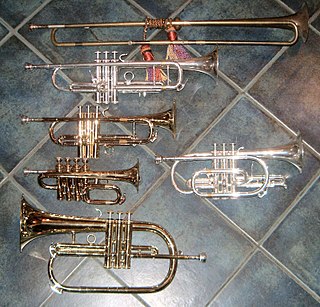
A brass instrument is a musical instrument that produces sound by sympathetic vibration of air in a tubular resonator in sympathy with the vibration of the player's lips. Brass instruments are also called labrosones or labrophones, from Latin and Greek elements meaning 'lip' and 'sound'.

The cornet is a brass instrument similar to the trumpet but distinguished from it by its conical bore, more compact shape, and mellower tone quality. The most common cornet is a transposing instrument in B♭. There is also a soprano cornet in E♭ and cornets in A and C. All are unrelated to the Renaissance and early Baroque cornett.

The euphonium is a medium-sized, 3 or 4-valve, often compensating, conical-bore, tenor-voiced brass instrument that derives its name from the Ancient Greek word εὔφωνος euphōnos, meaning "well-sounding" or "sweet-voiced". The euphonium is a valved instrument. Nearly all current models have piston valves, though some models with rotary valves do exist.

The flugelhorn, also spelled fluegelhorn, flugel horn, or flügelhorn, is a brass instrument that resembles the trumpet and cornet but has a wider, more conical bore. Like trumpets and cornets, most flugelhorns are pitched in B♭, though some are in C. It is a type of valved bugle, developed in Germany in the early 19th century from a traditional English valveless bugle. The first version of a valved bugle was sold by Heinrich Stölzel in Berlin in 1828. The valved bugle provided Adolphe Sax with the inspiration for his B♭ soprano (contralto) saxhorns, on which the modern-day flugelhorn is modeled.

The French horn is a brass instrument made of tubing wrapped into a coil with a flared bell. The double horn in F/B♭ is the horn most often used by players in professional orchestras and bands, although the descant and triple horn have become increasingly popular. A musician who plays a horn is known as a horn player or hornist.

The trombone is a musical instrument in the brass family. As with all brass instruments, sound is produced when the player's vibrating lips cause the air column inside the instrument to vibrate. Nearly all trombones use a telescoping slide mechanism to alter the pitch instead of the valves used by other brass instruments. The valve trombone is an exception, using three valves similar to those on a trumpet, and the superbone has valves and a slide.

The trumpet is a brass instrument commonly used in classical and jazz ensembles. The trumpet group ranges from the piccolo trumpet—with the highest register in the brass family—to the bass trumpet, pitched one octave below the standard B♭ or C trumpet.
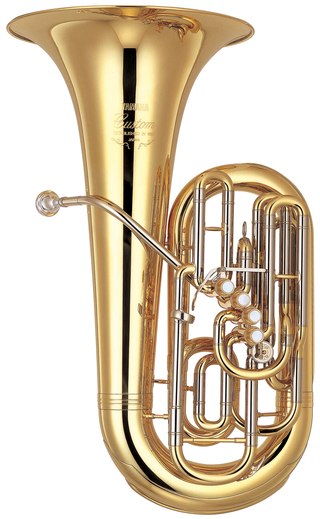
The tuba is the lowest-pitched musical instrument in the brass family. As with all brass instruments, the sound is produced by lip vibration – a buzz – into a mouthpiece. It first appeared in the mid-19th century, making it one of the newer instruments in the modern orchestra and concert band. The tuba largely replaced the ophicleide. Tuba is Latin for "trumpet".
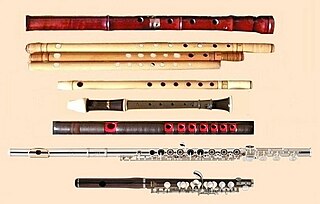
An aerophone is a musical instrument that produces sound primarily by causing a body of air to vibrate, without the use of strings or membranes, and without the vibration of the instrument itself adding considerably to the sound.

The tenor horn is a brass instrument in the saxhorn family and is usually pitched in E♭. It has a bore that is mostly conical, like the flugelhorn and euphonium, and normally uses a deep, cornet-like mouthpiece.

A piston valve is a device used to control the motion of a fluid along a tube or pipe by means of the linear motion of a piston within a chamber or cylinder.

The Vega Company was a musical instrument manufacturer that started operations in Boston, Massachusetts in 1881. The company began under Swedish-born Julius Nelson, his brother Carl, and a group of associates that included John Pahn and John Swenson. The founders had previously worked for a guitar shop run by Pehr Anderberg that made instruments for John C. Haynes, another Boston musical instrument company. Nelson had served as foreman of guitar and mandolin manufacturing at Anderberg's shop. Subsequently, Julius and Carl Nelson bought out the other founding associates and established the Vega company.

Besson is a manufacturer of brass musical instruments. It is owned by Buffet Crampon, which bought Besson in 2006 from The Music Group.

Marching brass instruments are brass instruments specially designed to be played while moving. Most instruments do not have a marching version - only the following have marching versions:

Ernst Albert Couturier was best known as a cornet player who toured as a "virtuoso" performer on the concert programs of bands of the day. He promoted the Holton Band Instrument Company for a decade in that capacity before applying his own unique inventions to the production of his own line of brass band instruments between 1918 and 1923.
Foster Allen Reynolds was an American brass instrument designer and manufacturer.
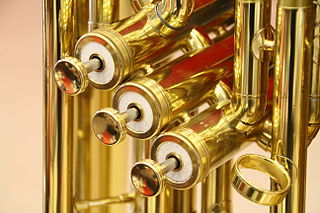
Brass instrument valves are valves used to change the length of tubing of a brass instrument allowing the player to reach the notes of various harmonic series. Each valve pressed diverts the air stream through additional tubing, individually or in conjunction with other valves. This lengthens the vibrating air column thus lowering the fundamental tone and associated harmonic series produced by the instrument. Valves in brass instruments require regular maintenance and lubrication to ensure fast and reliable movement.

A horn is any of a family of musical instruments made of a tube, usually made of metal and often curved in various ways, with one narrow end into which the musician blows, and a wide end from which sound emerges. In horns, unlike some other brass instruments such as the trumpet, the bore gradually increases in width through most of its length—that is to say, it is conical rather than cylindrical. In jazz and popular-music contexts, the word may be used loosely to refer to any wind instrument, and a section of brass or woodwind instruments, or a mixture of the two, is called a horn section in these contexts.
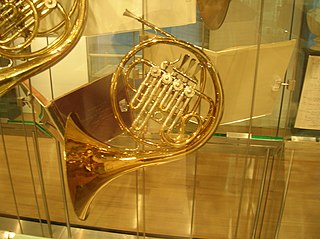
The German horn is a brass instrument made of tubing wrapped into a coil with a flared bell, and in bands and orchestras is the most widely used of three types of horn, the other two being the French horn and the Vienna horn. Its use among professional players has become so universal that it is only in France and Vienna that any other kind of horn is used today. A musician who plays the German horn is called a horn player. The word "German" is used only to distinguish this instrument from the now-rare French and Viennese instruments. Although the expression "French horn" is still used colloquially in English for any orchestral horn, since the 1930s professional musicians and scholars have generally avoided this term in favour of just "horn". Vienna horns today are played only in Vienna, and are made only by Austrian firms. German horns, by contrast, are not all made by German manufacturers, nor are all French-style instruments made in France.